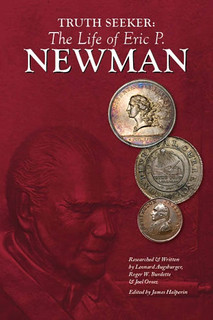
PREV ARTICLE
NEXT ARTICLE
FULL ISSUE
PREV FULL ISSUE
BOOK REVIEW: TRUTH SEEKER: LIFE OF ERIC P. NEWMAN
Bill Eckberg published a review of the new biography of Eric Newman in the July 2016 issue of Penny-Wise, the official publication of Early American Coppers, Inc. With permission, here is an excerpt.
-Editor
TRUTH SEEKER: THE LIFE OF ERIC P. NEWMAN
The story begins with his early life, including meeting Evelyn, who would be the love of his life and his wife from 1939-2015 when she passed away at 95. He worked as a lawyer for the Edison Brothers Stores until his retirement in 1987, and he continues to be active in numismatics at [105] years young. The book chronicles his interactions with a number of famous numismatists, including Wayte Raymond, F.C.C. Boyd, John J. Ford, Jr., Q. David Bowers, Walter Breen, Don Taxay, George Fuld, Kenneth Bressett, John W. Adams, and many others. As a young lawyer, he came under the wing of St. Louis coin dealer Burdette Johnson. Together, they worked out an “arrangement” to purchase as much of the numismatic estate of “Col.” E.H.R. Green as they could. It’s a fascinating story, and I won’t give it away, how a young lawyer managed to put together at little cost one of the finest collections of American coins and currency ever assembled. Do you want to know EXACTLY when the Missouri Cabinet got its start? It’s in there. Newman’s involvement in that cabinet was kept so quiet that even McCawley and Grellman didn’t know about it until the day the collection was consigned to them for auction! Newman’s fame in the broader field of U.S. numismatics comes from his application of a more rigorous, scholarly and scientific approach than had been previously known in numismatic research. He relied on contemporary documentation, for sure, but mostly he studied the coins and other items to find out what they, themselves, could tell him. His early research proved that both the Good Samaritan Shilling and the 1804 U.S. dollar were fantasy pieces. (Newman never owned an 1804 dollar, because he wanted to collect only genuine coins.) Later he had a severe falling-out with his former friend, the coin dealer John J. Ford, Jr., who had quite a business in the ‘50s and ‘60s selling previously unknown gold bars that were purported to come from old Mexico and the American west, most of which Newman denounced as fakes. Decades later, the courts agreed with Newman, finding that they were instead produced on Long Island in the 20th century. You will probably be amazed at the names of the prominent numismatists of the time who had significant financial interests in these fakes. I think Augsburger et al. titled the book Truth Seeker because that’s what Eric Newman is. His ethics are impeccable. He follows the evidence where it goes and, remarkably, has never had a financial interest in any of his research. He has given away his entire collection to the Eric P. Newman Numismatic Education Society foundation for the education of numismatists of today and tomorrow. His quest for truth and ethics was not limited to numismatics, either. In 1961, as President of the A.N.A., he wrote the Biltmore Hotel in Atlanta that he would not be participating in the ANA convention if African-American members would not be served at the banquet. The hotel relented. He continues to be an inspiration to us all, and this book does him credit. Eric Newman remains a current EAC member, with number 2577.
For more information about Early American Coppers, see:
The Numismatic Bibliomania Society is a non-profit organization promoting numismatic literature. See our web site at coinbooks.org. To submit items for publication in The E-Sylum, write to the Editor at this address: whomren@gmail.com To subscribe go to: https://my.binhost.com/lists/listinfo/esylum All Rights Reserved. NBS Home Page Contact the NBS webmaster 
|
